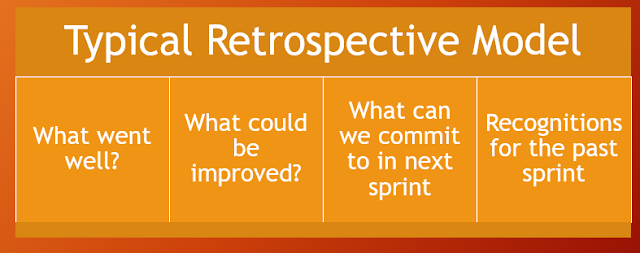In this article, we will go through the most interesting and challenging ceremonies of agile. This article will provide an structured way of executing retrospective meetings and lists down what worked for me to get optimum results.
Phase 1
Kick off your retrospective by
showing following metrics to the team, which is the reflection of how we did in
current sprint vs historical sprints. This is critical for initiating a
conversation between teams. At this stage, i do not encourage team to ask any
question or start a conversation immediately, the scrum master should take few
minutes summarizing the iteration. While scrum master is speaking, every other
team member is visualizing this data generating constructive thoughts around
the data points.
Following are some of the examples of data point you can use for a typical software development project.
a. Sprint Velocity Historical vs Current Sprint
b. Carry Over
Stories Historical vs Current Sprint
c. Defect
Density Historical vs Current Sprint
d. Defect Leakage
e. Bugs Story/Sprint/Release
Historical vs Current
f. Lead time or Cycle time
Phase 2
I discovered a structured way
of executing retrospective, which worked for me and I use this methodology in
coaching and training too. This is derived from book Agile Retrospectives: Making Good Teams
Great by Esther Derby and Diana Larsen.
The
five stages of retrospective are:
1.
Setting stage
2.
Gathering data
3.
Generating Insight
4.
Defining what to do
5.
Close
Setting stage
During this stage you should start by
asking
team's interest in retrospective, understand the top two or three outcomes which they want as a take away from this
discussion.
There are times when team are routinely running common
questions in retrospectives which becomes ineffective over a period of time and do
not result in any outcomes.
Encourage teams to have open ended discussion on variety of topics, some of the
examples are
- Benefits of XP practices inducted from last iterations.
- Ideas on improvement to current automation.
- Gather training needs.
- Inquiry over Advocacy
- Dialog over Debate
- Conversation over Argument and
- Understanding over Defending individual points
This needs to be taken care very
amicably. Based on few experienced scrum masters, some members take it as they
are being questioned for in-competence directly.
Gathering data
This stage is carried out by looking
back on the sprint and team members should do a self-retrospective. The data
point or facts presented in Phase 1 is a key in data gathering.
Generating Insight
Good data is the foundation for the process. Data collected from above phases Phase 1 and Phase 2 (Generating data) helps us get an insight on past performance and improvement areas.
This stage helps us
1. Generate shared understanding
2. Identify the underlying causes by performing pattern identification or root cause analysis
This stage helps us
1. Generate shared understanding
2. Identify the underlying causes by performing pattern identification or root cause analysis
Defining what to do
This chapter of the ceremony contains
1. Actionable items
2. Owners and
3. Due date
Identify maximum two improvements we can do as a group in next iteration. This may be an experiment. But remember to pick an improvement which will benefit the whole team and is aligned to product/feature development.
Following are few examples of next steps
Engineering focused
1. Focus on XP practices
a. Give more attention to pair programming
b. Spend more time refactoring
c. Increase the quality of code coverage
2. Increased quality by reduced defects and re-work
3. Increased focus on Continuous Integration
Team focused
4. Have more frequent on-shore offshore meetings
5. Meet on a VC rather than phone call (This we had in our retro, we followed & it really helped)
Tips to prioritize and finalize improvements which will be taken up by team
1. Create an idea board of commitments which team has shortlisted
2. Get vote on each one of the idea
3. Pick top 2 or 3 improvements areas which received maximum votes.
4. Assign this next step to a team member along with a due date followed by regular checkpoints on progress.
Close
Review all the above steps and do not forge to monitor this during scrum call. Typically, retrospectives should last no more than 1.5 hours for a two-week sprint.Out comes
Few outcomes from running effective retrospective are listed below
- Higher Trust and Moral among teams and team members
- Improved capability of team
- Improved capacity of team
- Improved efficiency of team
- Improved Quality of product delivered by team
https://www.yodiz.com/blog/agile-retrospective/
https://www.youtube.com/watch?v=w8w-dFrmovQ
https://www.scrum.org/resources/what-is-a-sprint-retrospective
https://slideplayer.com/slide/6054927/
https://www.youtube.com/watch?v=w8w-dFrmovQ
https://www.scrum.org/resources/what-is-a-sprint-retrospective
https://slideplayer.com/slide/6054927/
Contributions
Pavas Malviya, Scrum Master, Sapient ConsultingAmit Kumar, Scrum Master, Sapient Consulting


No comments:
Post a Comment